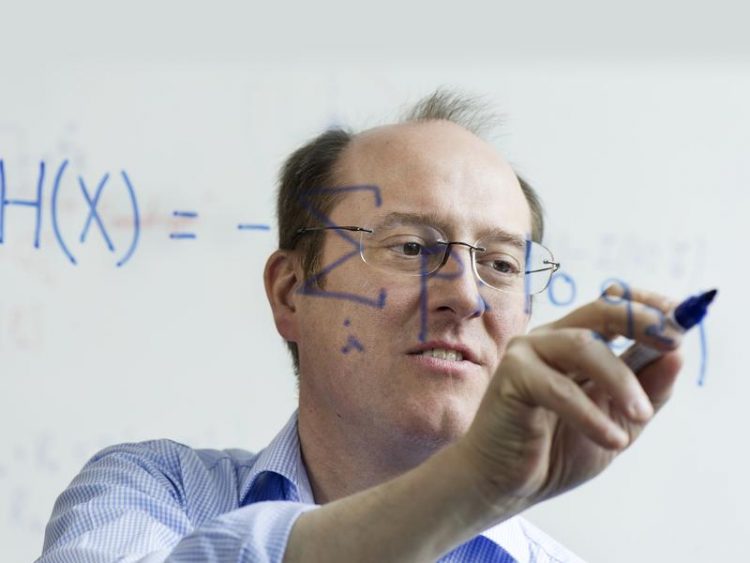Optical fiber transmits one terabit per second – Novel modulation approach

Prof. Dr. Gerhard Kramer Astrid Eckert / TUM
The demonstration shows that the flexibility and performance of optical networks can be maximized when adjustable transmission rates are dynamically adapted to channel conditions and traffic demands. As part of the Safe and Secure European Routing (SASER) project, the experiment over a deployed optical fiber network of Deutsche Telekom achieved a net 1 Terabit transmission rate.
This is close to the the theoretical maximum information transfer rate of that channel and thus approaching the Shannon Limit of the fiber link. The Shannon Limit was discovered in 1948 by Claude Shannon, Bell Labs pioneer and the “father of information theory.”
Novel modulation approach
The trial of the novel modulation approach, known as Probabilistic Constellation Shaping (PCS), uses quadrature amplitude modulation (QAM) formats to achieve higher transmission capacity over a given channel to significantly improve the spectral efficiency of optical communications.
PCS modifies the probability with which constellation points – the alphabet of the transmission – are used. Traditionally, all constellation points are used with the same frequency. PCS cleverly uses constellation points with high amplitude less frequently than those with lesser amplitude to transmit signals that, on average, are more resilient to noise and other impairments. This allows the transmission rate to be tailored to ideally fit the transmission channel, delivering up to 30 percent greater reach.
Maximal transmission capacity
It was 50 years ago when optical fiber was introduced. With the promise of 5G wireless technology on the horizon, optical transport systems today continue to evolve to help telecommunications operators and enterprises meet network data traffic growing at a cumulative annual rate of up to 100 percent.
PCS is now part of this evolution by enabling increases in optical fiber flexibility and performance that can move data traffic faster and over greater distances without increasing the optical network complexity.
The research is a key milestone in proving PCS could be used in the future to extend optical communication technologies. The results of this joint experiment will be presented at the European Conference on Optical Communication (ECOC) 2016 in Düsseldorf, Germany on September 19.
Transmitting data faster, further, and with unparalleled flexibility
“Increased capacities, reach and flexibility over deployed fiber infrastructures,” said Bruno Jacobfeuerborn, Director Technology Telekom Deutschland and CTO Deutsche Telekom. “Deutsche Telekom provides a unique network infrastructure to evaluate and demonstrate such highly innovative transmission technologies for example. Furthermore, it also supports higher layer test scenarios and technologies.”
“Information theory is the mathematics of digital technology, and during the Claude E. Shannon centenary year 2016 it is thrilling to see his ideas continue to transform industries and society,” said Professor Gerhard Kramer, Head of the Institute for
Communications Engineering at Technical University of Munich.
“Probabilistic constellation shaping, an idea that won a Bell Labs Prize, directly applies Shannon’s principles and lets fiber optic systems transmit data faster, further, and with unparalleled flexibility,” added Prof. Kramer. “The success of the close collaboration with Nokia Bell Labs, who further developed the technology, and Deutsche Telekom T-Labs, who tested it under real conditions, is satisfying confirmation that TUM Engineering is a label of outstanding quality, and that TUM teaching gives our students the intellectual tools to compete, succeed and lead globally.”
Marcus Weldon, president Nokia Bell Labs & Nokia CTO, said: “Future optical networks not only need to support orders of magnitude higher capacity, but also the ability to dynamically adapt to channel conditions and traffic demand. Probabilistic Constellation Shaping offers great benefits to service providers and enterprises by enabling optical networks to operate closer to the Shannon Limit to support massive datacenter interconnectivity and provide the flexibility and performance required for modern networking in the digital era.”
https://www.tum.de/en/about-tum/news/press-releases/short/article/33398/ Press release
https://www.tum.de/en/about-tum/news/press-releases/short/article/32802/ Press release Bell Labs Prize
http://www.lnt.ei.tum.de/en/home/ Homepage Institute for Communications Engineering
Media Contact
All latest news from the category: Information Technology
Here you can find a summary of innovations in the fields of information and data processing and up-to-date developments on IT equipment and hardware.
This area covers topics such as IT services, IT architectures, IT management and telecommunications.
Newest articles

Bringing bio-inspired robots to life
Nebraska researcher Eric Markvicka gets NSF CAREER Award to pursue manufacture of novel materials for soft robotics and stretchable electronics. Engineers are increasingly eager to develop robots that mimic the…

Bella moths use poison to attract mates
Scientists are closer to finding out how. Pyrrolizidine alkaloids are as bitter and toxic as they are hard to pronounce. They’re produced by several different types of plants and are…

AI tool creates ‘synthetic’ images of cells
…for enhanced microscopy analysis. Observing individual cells through microscopes can reveal a range of important cell biological phenomena that frequently play a role in human diseases, but the process of…





















